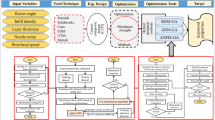Abstract
In recent years, nano-structured hardfacing alloy constituting fine carbides, borides and boro-carbides have become pioneered in modern manufacturing industries due to their superior properties (excellent hardness, toughness and wear resistance) even at elevated temperatures. A nano-structured hardfacing alloy component was produced using manual metal arc welding process for making turning tool insert. The present paper investigates the effect of wire electrical discharge machining (WEDM) parameters such as discharge pulse time, discharge stop time, servo voltage, wire tension and wire feed rate on machining performances viz. material removal rate, machining time and surface roughness after proof-machining of welded nano-structured hardfacing material. Taguchi’s (L25) orthogonal array has been used to perform the experimental runs using conventional brass wire and zinc-coated wire electrodes, respectively. A combination of Taguchi’s robust design concept with principal component analysis has been applied to optimize the process parameters. For brass wire, the optimal settings of the input process parameters corresponds to discharge pulse time 0.45 µs, discharge stop time 8 µs, servo voltage 35 V, wire tension 800 g and wire feed rate 7 m/min, respectively. Similarly, for zinc-coated brass wire, the corresponding settings are discharge pulse time 0.5 µs, discharge stop time 11 µs, servo voltage 41 V, wire tension 600 g and wire feed rate 7 m/min. This paper also establishes the inter-relationships of various WEDM machining parameters and performances by employing response surface methodology-based approach. A confirmation test has also been carried out with the optimal process parameters to conform to the experimental result.










Similar content being viewed by others
References
Bing-quan C, Cang-xiu C, Jun-bo P (2003) A high-Fe aluminum matrix welding filler metal for hardfacing aluminum–silicon alloys. J Wuhan Univ Technol Mater Sci Ed 18(1):25–28
Mahapatra SS, Patnaik A (2006) Parametric optimization of wire electrical discharge machining (wire EDM) process using Taguchi method. J Braz Soc Mech Sci Eng 28(4):422–429
Bobbili R, Madhu V, Gogia AK (2013) Effect of wire-EDM machining parameters on surface roughness and material removal rate of high strength armor steel. Mater Manuf Process 28(4):364–368
Dhobe MM, Chopde IK, Gogte CL (2014) Optimization of wire electro discharge machining parameters for improving surface finish of cryo-treated tool steel using DOE. Mater Manuf Process 29:1381–1386
Fonda P, Katahira K, Yamazaki K (2012) WEDM condition parameter optimization for PCD microtool geometry fabrication process and quality improvement. Int J Adv Manuf Technol 63:1011–1019
Kumar A, Kumar V, Kumar J (2014) Microstructure analysis and material transformation of pure titanium and tool wear surface after wire electric discharge machining process. Mach Sci Technol 18:47–77
Li L, Li ZY, Wei XT, Cheng X (2015) Machining characteristics of Inconel 718 by sinking-EDM and wire-EDM. Mater Manuf Process 30(8):968–973
Mandal A, Dixit AR, Das AK, Mandal N (2015) Modeling and optimization of machining nimonic C-263 super alloy using multicut strategy in WEDM. Mater Manuf Process. doi:10.1080/10426914.2015.1048462
Manjaiah M, Narendranath S, Basavarajappa S, Gaitonde VN (2015) Effect of electrode material in wire electro discharge machining characteristics of T i50N i50-x Cux shape memory alloy. Precis Eng 41:68–77
Shyam L, Sudhir K, Khan ZA, Siddiquee AN (2013) Wire electrical discharge machining of AA7075/SiC/Al2O3 hybrid composite fabricated by inert gas-assisted electromagnetic stir-casting process. J Braz Soc Mech Sci Eng 36(2):335–346
Shayana AV, Afzac RA, Teimourib R (2013) Parametric study along with selection of optimal solutions in dry wirecut machining of cemented tungsten carbide (WC–Co). J Manuf Process 15(4):644–658
Zhang GJ, Zhang Z, Guo JW, Ming WY, Li MZ, Huang Y (2013) Modelling and optimization of medium-speed WEDM process parameters for machining SKD11. Mater Manuf Process 28(10):1124–1132
Ross PJ (1996) Taguchi techniques for quality engineering. Mc Graw-Hill, New York
Gong YD, Sun Y, Wen XL, Zhou YG, Liu Y (2016) Experimental study on accuracy and surface quality of TC2 in LS-WEDM multiple cuts. J Braz Soc Mech Sci Eng. doi:10.1007/s40430-016-0513-y
Pearson K (1901) On lines and planes of closet fit to systems of points in space. Phil Manag Ser 6(2):559–572
Mondal SC, Maiti J, Ray PK (2010) Development of a measurement metric for manufacturing process robustness. Int J Prod Qual Manag 6(2):156–181
Mondal SC, Ray PK, Maiti J (2013) Modelling robustness for manufacturing processes: a critical review. J Prod Res 2(2):521–538
Garg SK, Manna A, Jain A (2016) Experimental investigation of spark gap and material removal rate of Al/ZrO2 (P)-MMC machined with wire EDM. J Braz Soc Mech Sci Eng 38(2):481–491
Kumar A, Kumar V, Kumar J (2015) Semi-empirical model on MRR and overcut in WEDM process of pure titanium using multi-objective desirability approach. J Braz Soc Mech Sci Eng 37(2):689–721
Chalisgaonkar R, Kumar J (2013) Optimization of WEDM process of pure titanium with multiple performance characteristics using Taguchi’s DOE approach and utility concept. Front Mech Eng 8(2):201–214
Sharma P, Chakradhar D, Narendranath S (2015) Evaluation of WEDM performance characteristics of Inconel 706 for turbine disk application. Mater Des 88:558–566
Yan BH, Tsai HC, Huang FY, Lee LC (2005) Examination of wire electrical discharge machining of Al2O3p/6061Al composites. Int J Mach Tools Manuf 45:251–259
Kuriakose S, Shunmugam MS (2004) Characteristics of wire-electro discharge machined Ti6Al4V surface. Mater Lett 58:2231–2237
Liao YS, Huang JT, Su HC (1997) A study on the machining-parameters optimization of wire electrical discharge machining. J Mater Process Technol 71(3):487–493
GöklerMİ Ozanözgü AM (2000) Experimental investigation of effects of cutting parameters on surface roughness in the WEDM process. Int J Mach Tools Manuf 40(13):1831–1848
Acknowledgments
The authors are very thankful to the reviewers for their constructive comments and suggestions on how to improve the quality of this paper. The authors gratefully acknowledge the kind support and cooperation provided by M/s L & T Limited, India.
Author information
Authors and Affiliations
Corresponding author
Additional information
Technical Editor: Márcio Bacci da Silva.
Rights and permissions
About this article
Cite this article
Saha, A., Mondal, S.C. Experimental investigation and modelling of WEDM process for machining nano-structured hardfacing material. J Braz. Soc. Mech. Sci. Eng. 39, 3439–3455 (2017). https://doi.org/10.1007/s40430-016-0608-5
Received:
Accepted:
Published:
Issue Date:
DOI: https://doi.org/10.1007/s40430-016-0608-5




